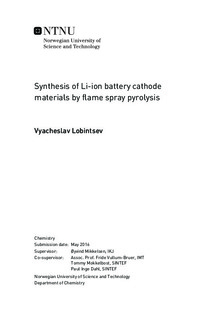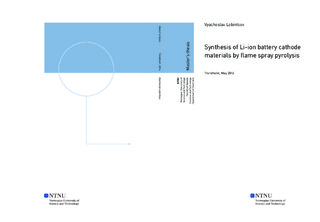| dc.description.abstract | Li-ion batteries (LIBs) constitute the leading technology within power sources. They are used in hybrid and pure electric vehicles as well as portable electronics and at the present time surpassed other types of battery systems with regard to energy density, cycling stability self-discharge and longer life time. Although well developed, LIBs still have tremendous potential for improvements and new materials are continuously being investigated. One of the main issues for cathode materials is their poor electronic and ionic conductivities, which limits their use in many different applications. One of the options to overcome this issue is obtaining of nanostructured materials with their further development on nanostructured scale. Lithium manganese orthosilicates and lithium iron orthosilicates one of the interesting and promising candidates of cathode materials, since for their synthesis used low price, environmentally benign and abundant precursor materials. Recently LMS/C and LFS/C have been synthesized by different methods. However, producing nanostructured materials on a large scale can be both time consuming and costly. This thesis is focused on Flame Spray Pyrolysis (FSP) technic for producing of nanosized (Li2MSiO4 where M=Fe, Mn) lithium transition metal orthosilicates cathode materials for battery technology, which utilizes pyrolysis of ethanol and p-xylene-based solutions of precursor cations. Nevertheless, in the beginning of thesis experiments the FSP was performed using H2O and ethanol solution. However, water negatively affected desired quality of obtained product and was decided to use waterless solvents for further synthesis.
Within this thesis LMS/C and LFS/C composites have been obtained. Phase identification and lattice parameters of the samples have been made using X-ray diffraction (XRD) and were indexed and refined to Pmn21 orthorhombic and P21/n monoclinic space groups respectively. Phase composition, crystallite size and lattice parameters have been analyzed by using Rietveld refinements method. Morphology of the LMS/C and LFS/C samples have been identified using scanning electron microscope (SEM). LMS/C sample with addition of P-xylene as a fuel enhancement formed primary particles in 26 nm in diameter and LFS/C with using iron acetylacetonate as iron precursor showed mean particles size 23 nm in diameter. Surface area and pore size identification of the obtained composites have been made by using BET analysis. Carbon content of the samples have been identified by thermogravimetric analysis (TGA). In this thesis in addition to normally fabricated cathodes to improve electrochemical properties were fabricated cathodes with applied pressure in 2 tons for 2 min, which shown enhancement in conductivity during electrochemical performance at 2C current rate to 11 % more compared with the same cathode without pressure. Electrochemical testing in case of LMS/C was carried out with one most promising sample based on morphological investigations, specific surface area and phase purity. In case of LFSs electrochemical cycling have been made with all obtained samples. It was shown that the highest discharge capacity was achieved in case with LFSs of 140 mAhg-1 and for the LMS of 192mAhg-1. After 20 cycles at different current range LFS showed capacity retain of 93% from initial and after 100 cycles the LFS showed stable behavior with capacity retain of 84 %. | |

